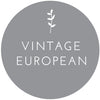How Do I Choose Which Type of Oilcloth to buy?
We offer several types of oilcloth but when it comes down to it, they are all wipeable fabrics and the choice of which one to buy is down to personal preference.
The Danish oilcloth tends to be thinner than the English and comes on rolls approx 140cm wide. It has a shiny gloss finish.
The English oilcloth can be either a matt or gloss finish (specified on the product page), is slightly thicker and comes on rolls approximately 130cm wide.
Gloss is a traditional finish which is found on the vast majority of tablecloths. It tends to bring out the colours in the fabrics.
With matt, you get a subtler look, with the end result more closely resembling cloth fabric. Matt is also softer to the touch. We have tested it over the years on our own tables with a messy family and have found it to be as durable and wipeable as the gloss finish - at the end of the day the choice is just personal preference.
The linen acrylic is a great product for special occasions like weddings, dinner parties, or any function where you want the look of linen but the ability to wipe it clean. It has a more natural fabric look than the oilcloths but if spills are wiped off before they dry, it is very durable. It cannot be put in a washing machine or ironed and, being linen, it is a little more expensive than the traditional oilcloths and comes on rolls approx 150 wide.
Oilcloth and Linen Acrylic Care and Maintenance
How Are They Made?
All of our English and Danish oilcloths are produced from a printed cotton weave which is then finished with a special wipe-clean vinyl coating. These vinyl coated tablecloths are given either a gloss or a matt finish during the coating process. The Linen Acrylic is made by impregnating 100% linen fabric with an acrylic coating.
Phthalates
All PVC and acrylics used are child-safe. The PVC used on all of our oilcloths has been specially formulated to conform to the current REACH regulations dictated by directive 2005/84/EC and so does not contain any restricted phthalates.
What will leave a stain on my cloth?
The PVC and acrylic coating is designed to give an easy care finish to the textiles, but unfortunately, it is not an armour plating. It will not withstand turmeric, ball-pen ink, lipstick, nail varnish or shoe polish. Some tomato based sauces and curry sauces can also leave marks and stains. These types of stains must be wiped immediately. Newspaper print can transfer onto the cloth if the cloth is still damp from wiping.
Hot cooking oil will also damage the surface. The surface will not withstand plates or dishes straight from the oven, placed directly upon it. Warm plates are fine.
Cleaning
All the oilcloths and linen acrylics are designed to be wiped clean using a damp cloth and mild detergent directly after use or as soon as possible after a spill. In most cases this is sufficient to keep them clean, however we all know life doesn’t always go according to plan so here are some tips for stains that have been left to dry on:
Cream cleaner: We find a small amount of jif cream cleaner is good for most stubborn stains.
Washing Machine: If the underside gets sticky finger marks or gets dirty over time the oilcloths can be put on a cold wash every now and then, but be aware that this can cause curling of the edges and if done too often, it will deteriorate the pvc coating. We would not recommend washing the danish gloss oilcloth as they can crease and the linen acrylic should never be washed in a machine.
Most stains will fade over time.
DO NOT DRY CLEAN ANY OF THE OILCLOTH OR LINEN ACRYLIC RANGE
Has your cloth developed creases?
To remove creases, the material may be ironed on the reverse side (the uncoated side) with a cool iron. The Linen Acrylic cannot be ironed but if left flat in a warm room all the creases should fall out after a day or so.
Outside use
Many people have oilcloths as outdoor tablecloths and they are great for this use. Some things to remember though: the tablecloths should not be left outside for prolonged periods after use to prevent the underneath (non-wipeable side) of the tablecloth from getting wet and dirty and the colour from fading too quickly.
